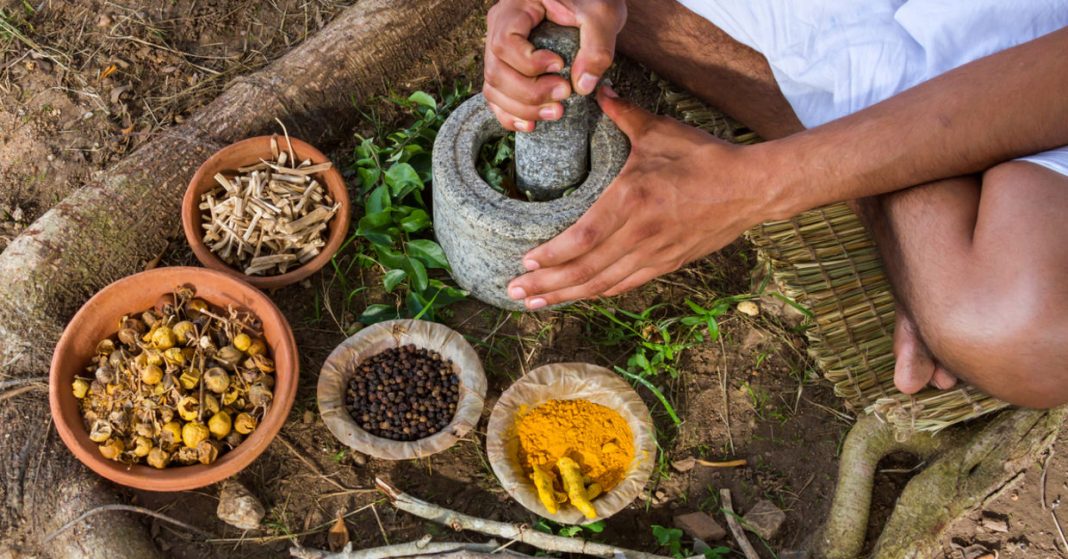You can use the powerful healing properties of Ayurvedic herbs and spices to balance your doshas. Some you’ll find already in your own kitchen! Balance from the inside out with these healthy ayurvedic herbs and spices.
So, what is Ayurveda? The ancient Indian practices of Ayurveda heal from the inside out through internal purification. Ayurveda comes from Sanskrit, meaning ayur (life) and veda (science or knowledge).
This knowledge of life provides a blueprint of wellness to support the doshas, energies that make up a person’s system. The doshas fall into three main categories: pitta, kapha, and vata. To balance your doshas, try these healthy ayurvedic herbs.
Ashwagandha
You can trace the use of the ashwagandha plant in India back over 6,000 years, according to an overview published in the African Journal of Traditional, Complementary, and Alternative Medicines. A member of the nightshade family, ashwagandha supports all body types, particularly the vita and kapha doshas because of its warming nature.
Health benefits: Helps relieve stress and anxiety, may reduce inflammation, boosts brain function
How to use it: Ashwagandha is commonly used as a churna, a finely sieved powder that mixes with water, ghee (clarified butter), and honey. The paste of the roots mixed with water reduces inflammation on joints or bites. You can also take it as a supplement to enjoy its healing benefits.
Brahmi
Want a brain boost? Ancient Vedic scholars took brahmi when they needed to memorize lengthy sacred scriptures. Reach for brahmi, or bacopa, a nootropic herb used in ayurveda to improve cognition, learning, and memory. It may also protect brain cells from Alzheimer’s disease and dementia, according to a study published in Rejuvenation Research.
Health benefits: Enhances cognitive function, helps alleviates anxiety, and may prevent brain disease
How to use it: Ayurvedic practitioners use the entire plant medicinally. You can take the herbal extract as a supplement, in an oral capsule or serum
Cardamom
Piney, fruity cardamom is a key ingredient in India’s famous masala chai. This warming spice supports all doshas, but those with a pitta imbalance should use it in moderation. Cardamom helps remove ama (toxins) from the body, great for relieving congestion and soothing coughs according to Lotus Blooming Herbs.
Health benefits: Antioxidant, anti-inflammatory, soothes coughs, relieves congestion
How to use it: Cardamom makes a great Ayurvedic skin treatment. Mix cardamom powder with raw organic honey and apply all over your face for a clear, glowing complexion. Or, add it to your tea mix for a spicy, invigorating blend. “The Queen of Spices” is pricey, but you can often save by purchasing it with a spice mix or tea.
Cumin
This earthy spice not only adds a pungent flavor to any meal, it also has many health benefits! In Ayurveda, cumin supports digestion, relaxes the muscles, and purifies the skin and blood, according to Joyful Belly. Because the warming spice has a drying effect (like a hot, cedar sauna), it pacifies kapha and vata while increasing fiery pity.
Health benefits: Relaxes the muscles, helps to purify blood and skin, aids digestion
How to use it: Cumin adds a rustic, earthy flavor to rice, meats, beans, and soups. Grind the seed pods or keep cumin powder in your pantry.
Cinnamon
Money might not grow on trees, but cinnamon does. This popular spice comes from the inner bark of tree species called Cinnamomum. In Ayurveda, cinnamon treats colds and provides an expectorant for the lungs by soothing mucus congestion (particularly important for kapha dosha), according to Joyful Belly.
Health benefits: helps treat colds and mucus in the lungs, freshens breath, ,may regulate blood sugar
How to use it: You’ve probably had cinnamon already in gingerbread cookies, applesauce, or beloved cinnamon rolls. You can also add cinnamon to spice up a chicken dish, or add it to your coffee or tea.
Amalaki
The Ancient Ayurvedic text, Charaka Samhita, states: “Of all the rasayanas (elixirs), Amalaki is revered as one of the most potent and nourishing; Amalaki is the best among rejuvenative herbs.” Amalaki, or Indian gooseberry, is the mother of herbs, because it takes care of the body so well. Unlike most fruits, amalaki contains five of the six ayurvedic tastes: sweet, sour, bitter, astringent, and pungent. This mix gives it a holistic, balancing effect on the doshas, which very few fruits have
Health benefits: Boosts immune system, promotes organ function in brain, heart, liver, and lungs
How to use it: When eaten as a fruit, amalaki leaves a sour taste in the mouth. You can also enjoy it as an elixir or tablet supplement.
Fenugreek
As one of the oldest medicinal plants, fenugreek seeds have been used for thousands of years and were even found in the tomb of Tutankhamen, according to Tour Egypt. In Ayurveda, fenugreek feeds your internal fire, driving out the cold and damp. This hot, bitter herb warms the lower half of the body, such as the kidneys, pelvis, lower back, and legs, according to Joyful Belly.
Health benefits: Removes phlegm, cools inflammation, warms lower body
How to use it: Best eaten in the spring, add fenugreek to teas mixed with mint, holy basil, cinnamon, lemon juice, and honey.
